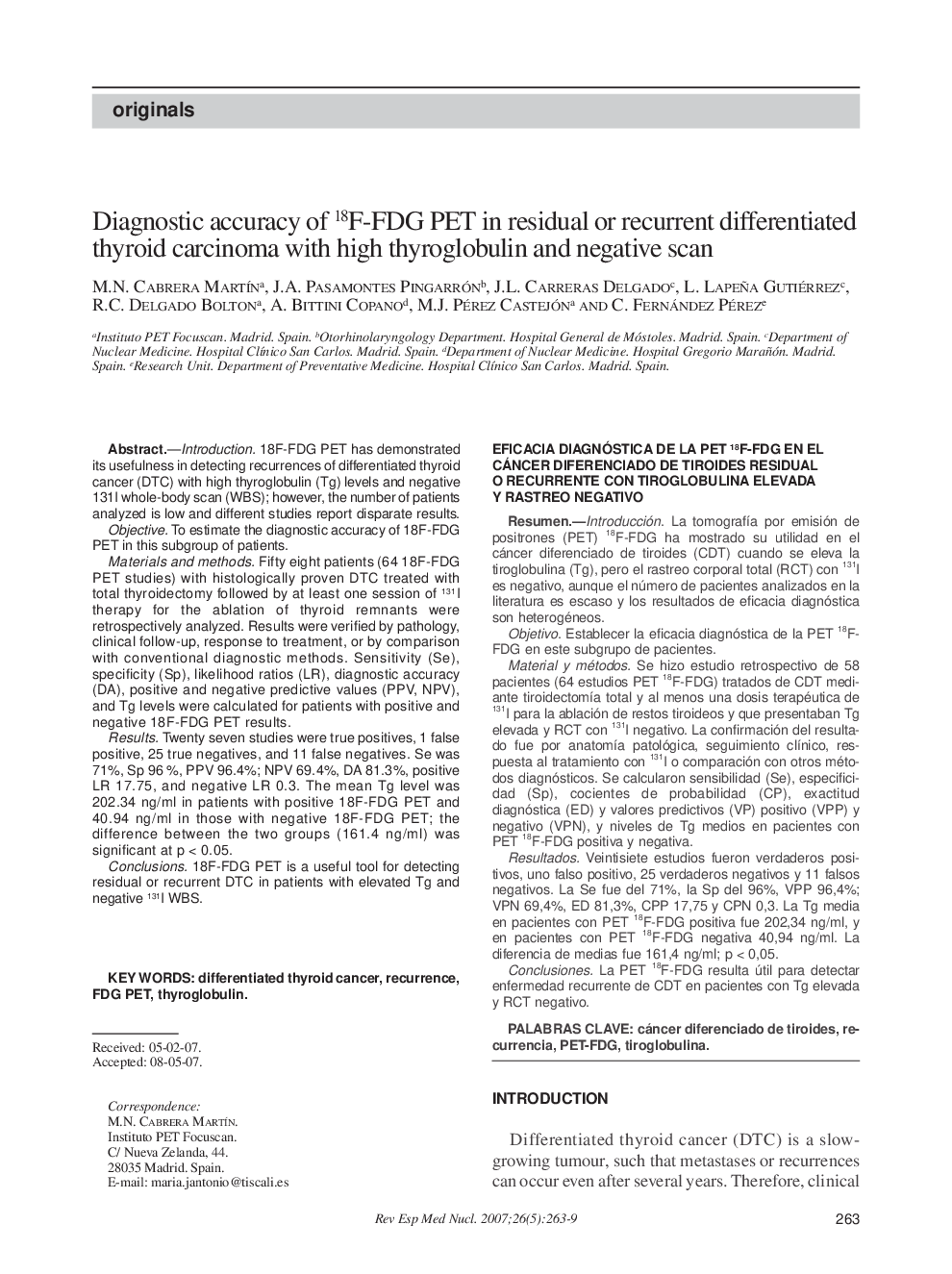| Article ID | Journal | Published Year | Pages | File Type |
|---|---|---|---|---|
| 4249633 | Revista Española de Medicina Nuclear (English Edition) | 2007 | 7 Pages |
Introduction18F-FDG PET has demonstrated its usefulness in detecting recurrences of differentiated thyroid cancer (DTC) with high thyroglobulin (Tg) levels and negative 131I whole-body scan (WBS); however, the number of patients analyzed is low and different studies report disparate results.ObjectiveTo estimate the diagnostic accuracy of 18F-FDG PET in this subgroup of patients.Materials and methodsFifty eight patients (64 18F-FDG PET studies) with histologically proven DTC treated with total thyroidectomy followed by at least one session of 131I therapy for the ablation of thyroid remnants were retrospectively analyzed. Results were verified by pathology, clinical follow-up, response to treatment, or by comparison with conventional diagnostic methods. Sensitivity (Se), specificity (Sp), likelihood ratios (LR), diagnostic accuracy (DA), positive and negative predictive values (PPV, NPV), and Tg levels were calculated for patients with positive and negative 18F-FDG PET results.ResultsTwenty seven studies were true positives, 1 false positive, 25 true negatives, and 11 false negatives. Se was 71%, Sp 96%, PPV 96.4%; NPV 69.4%, DA 81.3%, positive LR 17.75, and negative LR 0.3. The mean Tg level was 202.34 ng/ml in patients with positive 18F-FDG PET and 40.94 ng/ml in those with negative 18F-FDG PET; the difference between the two groups (161.4 ng/ml) was significant at p < 0.05.Conclusions18F-FDG PET is a useful tool for detecting residual or recurrent DTC in patients with elevated Tg and negative 131I WBS.
ResumenIntroducciónLa tomografía por emisión de positrones (PET) 18F-FDG ha mostrado su utilidad en el cáncer diferenciado de tiroides (CDT) cuando se eleva la tiroglobulina (Tg), pero el rastreo corporal total (RCT) con 131I es negativo, aunque el número de pacientes analizados en la literatura es escaso y los resultados de eficacia diagnóstica son heterogéneos.ObjetivoEstablecer la eficacia diagnóstica de la PET 18FFDG en este subgrupo de pacientes.Material y métodosSe hizo estudio retrospectivo de 58 pacientes (64 estudios PET 18F-FDG) tratados de CDT mediante tiroidectomía total y al menos una dosis terapéutica de 131I para la ablación de restos tiroideos y que presentaban Tg elevada y RCT con 131I negativo. La confirmación del resultado fue por anatomía patológica, seguimiento clínico, respuesta al tratamiento con 131I o comparación con otros métodos diagnósticos. Se calcularon sensibilidad (Se), especificidad (Sp), cocientes de probabilidad (CP), exactitud diagnóstica (ED) y valores predictivos (VP) positivo (VPP) y negativo (VPN), y niveles de Tg medios en pacientes con PET 18F-FDG positiva y negativa.ResultadosVeintisiete estudios fueron verdaderos positivos, uno falso positivo, 25 verdaderos negativos y 11 falsos negativos. La Se fue del 71%, la Sp del 96%, VPP 96,4%; VPN 69,4%, ED 81,3%, CPP 17,75 y CPN 0,3. La Tg media en pacientes con PET 18F-FDG positiva fue 202,34 ng/ml, y en pacientes con PET 18F-FDG negativa 40,94 ng/ml. La diferencia de medias fue 161,4 ng/ml; p < 0,05.ConclusionesLa PET 18F-FDG resulta útil para detectar enfermedad recurrente de CDT en pacientes con Tg elevada y RCT negativo.
